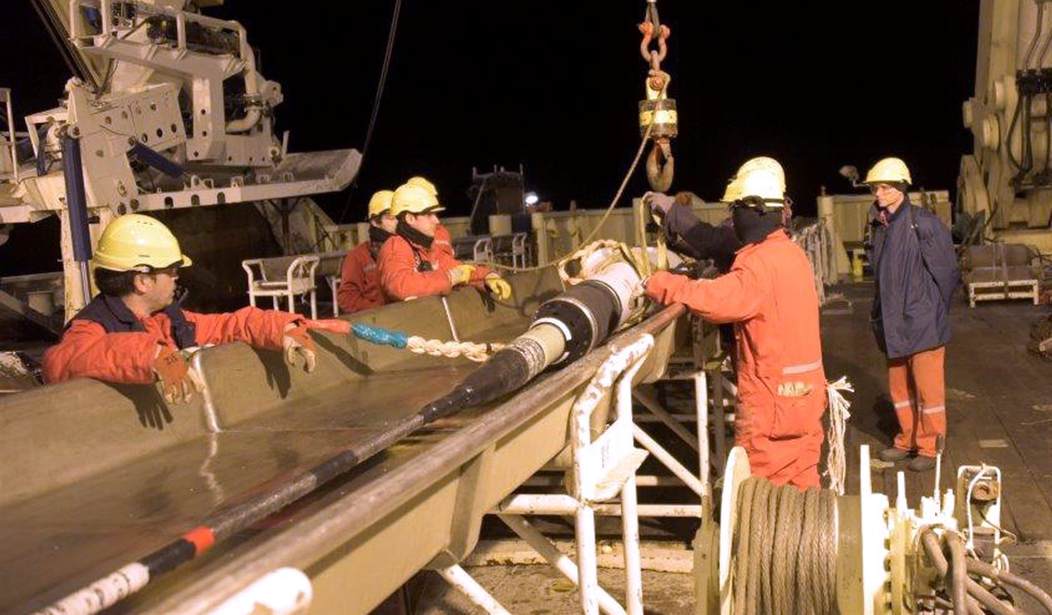Tramp cargo ships of murky registration love it when the world’s attention is focused on land-based conflicts. One looks very much like the other – ubiquitous rust buckets of the sea – floating serenely, aimlessly on ill-defined missions between ports. They also, being in such rough condition, could be expected to break down a lot…and so they seem to.
When no one’s looking, they’ll sometimes come to a stop over top of important things lying on the seabed beneath them. Like. for instance, the cables and pipelines that run communications, electricity, or natural gas between countries separated by seawater. In some cases, these are lifelines of one sort or another – like a huge power cable running to an isolated Swedish island, or natural gas to a continent that refuses to produce enough of their own.
In some cases damage happens because the ocean is a dangerous place and water is a hazard in itself.
… GUH chief executive, Neil Gordon, said, “It’s estimated that around 85% of the total value of offshore wind insurance claims relate to subsea cables. Insurers are losing money underwriting cables with the average settlement claim in the region of £9 million. Brokers have warned that the high number of cable claims is affecting capacity and coverage and the cost of repairs typically runs into millions, with warranties rarely covering the high cost of business interruption.
Marine cable and pipelines are tough to engineer and even tougher to fix when they break or fail in some fashion. Even finding the fault can be a frustrating ordeal in itself, and repairs can stretch into months of downtime.
…Global Power Marine fixes export cables and quotes one happy customer talking about needing “only” 32 days instead of 67 days to repair the cable. But all the while, part or all of the wind plant isn’t earning any income, and so much of any repair depends on getting good weather so a ship can hover and work uninterrupted while the cable is “dangling” and exposed.
Gulski et al estimate the duration of failure can be 1 to 3 or even up to 9 months:
“Last 20 years of experience shows that the power cables are the largest contributor to the failures of power supply from the offshore plants. “
For those who want the details on the challenges of engineering Gulski et al detail some of the problems with subsea cables like the need for armour that isn’t magnetic, sections that are 30-50 kilometers long to avoid “joints” underwater, and why most cables on the sea floor are called “wet structures” which allow water in (at least to the outer layers).
They’re also a security nightmare, which is becoming more and more apparent every single day.
On the same October 7th night when Hamas terrorists were rampaging through peaceful kibbitzes in Israel, both Russian and Chinese “cargo” vessels were in the “exact same location at the exact same time” when three subsea lines in the Baltic were damaged.
…On the night of 7 October, the 77-kilometre Balticconnector gas pipeline and a separate but close-by subsea telecommunications cable stretching between Finland and Estonia were damaged in the Gulf of Finland. A week later, it emerged that, on the same night, another subsea telecommunications cable—connecting Estonia and Sweden—had also been damaged.
…This case, however, appears to have been no accident.
Finland, Estonia and Sweden soon announced that the gas pipeline and cables had likely been deliberately damaged and were being investigated as related incidents.
At the centre of the investigation was a Russian state-owned nuclear-powered cargo ship, the Sevmorput. Russia has long posed a threat to vital subsea cables in the region, particularly since the start of the Ukraine war. The threat has escalated since the explosion of the Nord Stream gas pipeline in September 2022. Indeed, earlier this year Russia announced that it could damage subsea cables in retaliation for Nord Stream and European countries’ support for Ukraine. In June NATO even set up a subsea cable taskforce because of the high threat of Russian sabotage in the region. And with Finland recently joining NATO—and Sweden in the process of joining—it’s highly likely that Russia damaged the cables in retaliation.
However, another vessel was also reported to be under investigation—a Hong Kong–registered cargo ship, the NewNew Polar Bear, that had been travelling with the Russian vessel.
Tracking the vessels and the registry shifts is a quick little, really intriguing detective story.
Discussed with @PetteriOrpo and @SwedishPM the latest developments regarding the investigation of the undersea cables and Balticconnector incidents.
We also talked about the way forward, including improving the security of the critical infrastructure in the Baltic Sea. pic.twitter.com/2ssp8p9OcS
— Kaja Kallas (@kajakallas) October 26, 2023
The Russians have pooh-poohed accusations of their part in it, but the Chinese are playing things close to the vest. The threat from these meandering unfriendly vessels present, however, is decidedly real.
…The risk was underlined last year with attacks by unidentified saboteurs on the Nord Stream pipeline. Again this month, Finland and Sweden said a subsea gas pipeline and telecommunications cables had been damaged, including a link between NATO members Finland and Estonia. Finland said its review of vessels in the area at the time found a Russian and a Chinese ship among them.
President Vladimir Putin has dismissed the idea Russia was involved as “rubbish;” the Chinese shipowner, NewNew Shipping, declined to comment.
The Netherlands and Denmark have both accused Russian ships of attempting to map what Sweden’s Prime Minister has called a “spaghetti” of critical infrastructure in their waters.
When much of your “critical infrastructure” runs undersea as opposed to being in your backyard with a fence around it and a guard on duty, yeah. Time to fret.
The British, belatedly recognizing that their rush to off-shore their national power generation has compromised the very security of their entire electrical grid, had their own scare last week with Putin’s maritime marauders.
…A lack of generating capacity in the right place is only one of the problems with interconnectors. They also turn out to be rather unreliable. For example, the Western Link, one of the interconnectors from England to the South of Scotland has failed regularly in its short lifetime, going down for months at a time, causing nightmares for grid managers tasked with making up the difference. Similarly, the IFA1 interconnector to France was hit by a fire in 2021, losing half of its capacity for a period of more than a year. Of course, any part of the electricity grid can suffer an outage, but the loss of an interconnector can take out a significant proportion of supply for long periods.
Worse still, interconnectors represent a risk to security of supply in other ways. Those long cables, hidden deep beneath the waves, are an inviting target for hostile powers. Just last week, a small flotilla from the navies of several European nations was scrambled to an area adjacent to the East Anglia One windfarm, after a Russian vessel was seen to be hanging around the area. We can’t know if it was sizing up the windfarm’s grid connection or the adjacent gas pipeline, but the point is the same; it is very hard to protect subsea infrastructure from sabotage (and impossible when it is a thousand-mile cable from here to Morocco).
The NATO taskforce is a nice idea, but studying something that is already happening with critical infrastructure at risk is a problem that needs to be addressed immediately.
There is speculation in some quarters that the cable problems already inherent in the off-shore wind industry may finally be what sinks them, but when countries start to look at the additional security costs to maintain the juice running from turbine to shore, they may blanche in shock and horror. Wind companies are quite clear that they have no intention of paying for security anything. They’re just there to build and run them.
…The turbines have no barriers or surveillance.
“Our technicians are only here until five o’clock in the afternoon, then they go home,” said Thomas Almegaard, head of operations at Nysted wind farm, co-owned and operated by Denmark-based Orsted, the world’s biggest offshore wind developer.
“If the Russians wanted to cause damage, they could do it easily,” he told Reuters aboard a service vessel as it sailed through the wind farm.
“We don’t do any monitoring.”
…When it comes to who should pay for such measures, most governments said the buck stops with the developers.
Britain, which has spent 65 million pounds ($79 million) adapting two vessels for underwater surveillance and seabed warfare, said its government was responsible for security policy and works with industry to implement protection measures.
Seven other countries said the job of securing energy assets falls mainly to industry, although the naval forces play a role.
Officials at two large wind energy firms and at two defence companies told Reuters only a few wind farms have installed radars to monitor traffic. Otherwise, they said, no security equipment is installed today – because there are no requirements to do so and because of the cost.
“I think it’s extremely important to say that protection of assets within territorial waters is a state matter and not (that of) a developer,” Orsted CEO Mads Nipper told Reuters in April.
There are reports available from entities like The Atlantic Council with recommendations on improving undersea cable security, but it’s a daunting task. Governments are stepping up patrols in the Baltic and other bodies of water.
RT @velitesgear | Full Text Article: https://t.co/MMAmqxPd3j | Author: @defensie A look at Defence news 23 – 29 October Minehunters reinforce patrols following damage to undersea cables NATO’s SNMCMG1 fleet is intensifying its patrols in the Baltic Sea. This measure was taken b… pic.twitter.com/JqWHsqnSNG
— Velit.es (@velitesgear) November 1, 2023
But there’s a lot of vast stretches of ocean out there.
And it gets very, VERY deep.








Join the conversation as a VIP Member